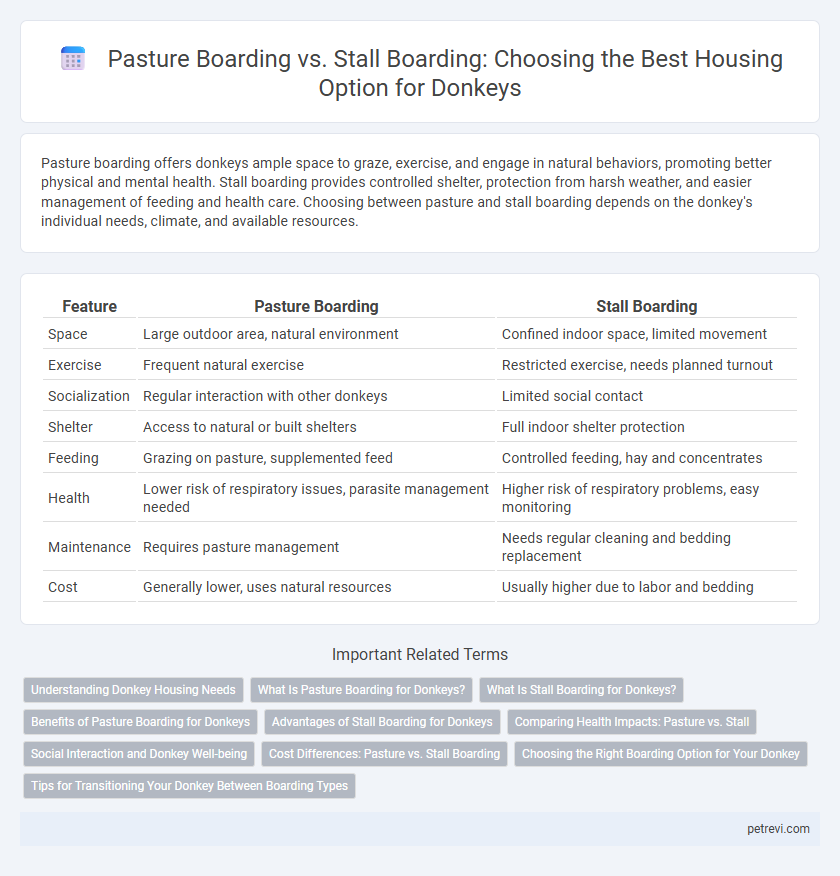Pasture boarding offers donkeys ample space to graze, exercise, and engage in natural behaviors, promoting better physical and mental health. Stall boarding provides controlled shelter, protection from harsh weather, and easier management of feeding and health care. Choosing between pasture and stall boarding depends on the donkey's individual needs, climate, and available resources.
Table of Comparison
| Feature | Pasture Boarding | Stall Boarding |
|---|---|---|
| Space | Large outdoor area, natural environment | Confined indoor space, limited movement |
| Exercise | Frequent natural exercise | Restricted exercise, needs planned turnout |
| Socialization | Regular interaction with other donkeys | Limited social contact |
| Shelter | Access to natural or built shelters | Full indoor shelter protection |
| Feeding | Grazing on pasture, supplemented feed | Controlled feeding, hay and concentrates |
| Health | Lower risk of respiratory issues, parasite management needed | Higher risk of respiratory problems, easy monitoring |
| Maintenance | Requires pasture management | Needs regular cleaning and bedding replacement |
| Cost | Generally lower, uses natural resources | Usually higher due to labor and bedding |
Understanding Donkey Housing Needs
Donkeys require housing that provides adequate shelter from extreme weather, with pasture boarding offering natural grazing and social interaction beneficial for their well-being. Stall boarding allows for better control of diet, health monitoring, and protection from predators, which is crucial in regions with harsh climates. Understanding these needs helps balance natural behavior with safety, ensuring donkeys receive appropriate care for both physical and mental health.
What Is Pasture Boarding for Donkeys?
Pasture boarding for donkeys involves housing them primarily outdoors in a managed pasture environment where they have continuous access to natural forage, fresh water, and shelter from weather elements such as sun and rain. This method supports the donkey's natural grazing behavior and promotes physical and mental well-being through increased movement and social interaction with other donkeys. Proper pasture management, including rotational grazing and safe fencing, is essential to maintain pasture quality and prevent overgrazing or injury.
What Is Stall Boarding for Donkeys?
Stall boarding for donkeys involves housing them in individual or shared enclosed spaces designed to protect from extreme weather and provide a controlled environment. These stalls typically feature ample ventilation, clean bedding, and easy access to food and water, optimizing the donkey's health and comfort. Stall boarding allows for better monitoring of health issues, feeding schedules, and behavioral management compared to pasture boarding.
Benefits of Pasture Boarding for Donkeys
Pasture boarding provides donkeys with ample space to roam, promoting natural foraging behavior that supports digestive health and mental well-being. Access to fresh grass and sunlight enhances vitamin D synthesis and reduces respiratory issues linked to confined stall environments. This housing method also encourages social interaction among donkeys, which is crucial for their emotional stability and overall happiness.
Advantages of Stall Boarding for Donkeys
Stall boarding for donkeys provides a controlled environment that protects them from extreme weather conditions and reduces the risk of injury or illness. It allows for easier monitoring of health and feeding schedules, ensuring tailored nutrition and prompt medical care. This housing method also minimizes exposure to parasites and predators, promoting overall well-being and longevity for donkeys.
Comparing Health Impacts: Pasture vs. Stall
Pasture boarding promotes natural grazing behavior and provides donkeys with ample exercise, reducing risks of obesity, colic, and respiratory issues commonly associated with poor ventilation in stall boarding. Stall boarding can lead to restricted movement and increased exposure to ammonia from urine buildup, elevating the likelihood of respiratory infections and hoof problems due to prolonged standing on hard surfaces. Choosing pasture boarding supports donkeys' physical and mental health by encouraging natural activity patterns and better air quality.
Social Interaction and Donkey Well-being
Pasture boarding offers donkeys ample space for natural social interaction, promoting mental stimulation and reducing stress through grazing and group dynamics. Stall boarding limits movement and social contact, which may lead to boredom and behavioral issues if companions are absent. Providing opportunities for regular social engagement is crucial for donkey well-being, making pasture boarding a preferred option for maintaining healthy, content animals.
Cost Differences: Pasture vs. Stall Boarding
Pasture boarding for donkeys generally incurs lower costs due to minimal infrastructure needs and the natural availability of grazing land, reducing feed expenses. Stall boarding involves higher costs, including barn maintenance, bedding, feed, and more frequent cleaning, which can significantly increase overall expenses. Owners must weigh these cost differences alongside factors like climate, donkey health, and management preferences to determine the most economical and suitable housing option.
Choosing the Right Boarding Option for Your Donkey
Pasture boarding offers donkeys ample space for natural grazing and exercise, promoting better mental and physical health. Stall boarding provides controlled shelter and protection from extreme weather but requires diligent daily care to ensure cleanliness and ventilation. Choosing the right option depends on your donkey's health, climate conditions, and your ability to provide consistent management.
Tips for Transitioning Your Donkey Between Boarding Types
Transitioning your donkey from pasture boarding to stall boarding requires gradual adjustment to prevent stress and health issues, starting with limited stall time and increasing duration daily. Monitor your donkey's behavior and health closely, providing consistent access to fresh water, appropriate forage, and regular exercise to maintain mental and physical well-being. Ensure the stall environment is clean, well-ventilated, and spacious enough to accommodate natural donkey movements to support a smooth transition.
Pasture Boarding vs Stall Boarding for Donkey Housing Infographic

 petrevi.com
petrevi.com